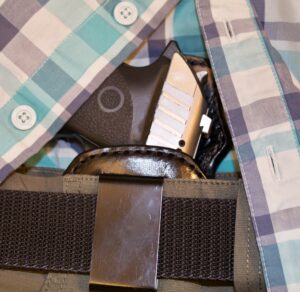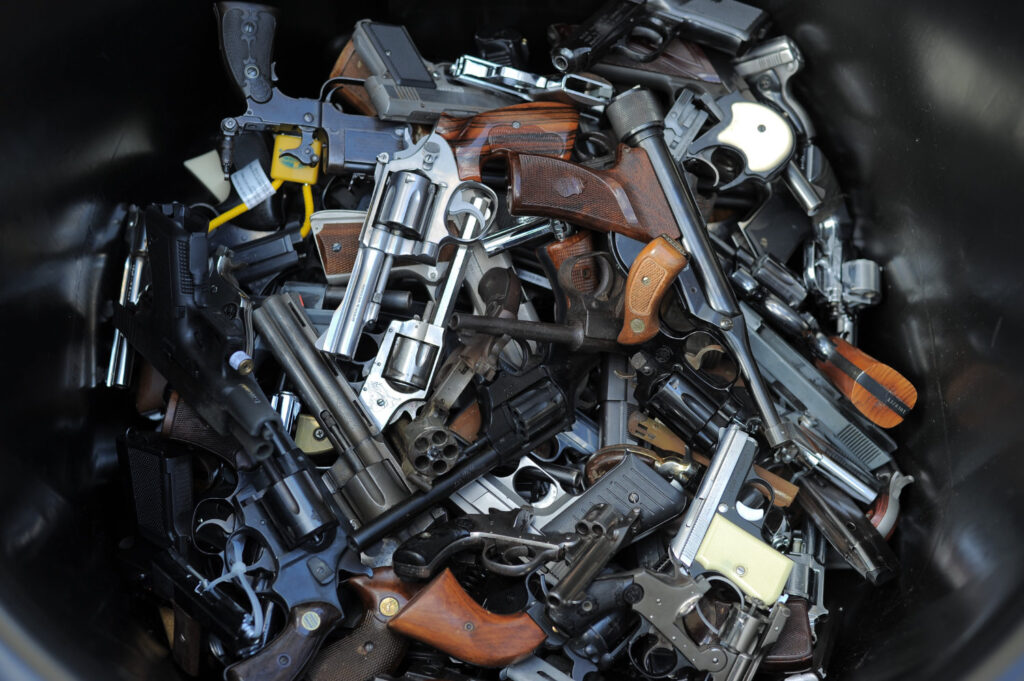‘Tis the season: some of you will soon be receiving a handgun for Christmas from a well-meaning loved one. While I hope to someday experience that joy firsthand…sniffle, sob…I am pleased, at least, that the guns I have amassed over the years are still very much to my liking. This is largely because I have selected them myself, and also because I have been methodical and studious in making my selections.
For those of you who, like me…sob, sniffle…will NOT be receiving a gun as a gift this Christmas, but plan to make your own acquisition, I would like to offer some pointers to help you navigate the handgun shopping process. The next ten minutes may save you time, money, and frustration, and I think you will find the read helpful and enjoyable. This whole gun-purchase thing is up to you, so you may as well do the job right!
We will treat this topic in two parts. First we’ll work to identify your needs and preferences. I’ll present some options for you to consider, and your careful responses will shape the outcome. Note: while it’s fine to solicit input, it is essential to focus on your needs and preferences as you make decisions. And second, I will present some strategies for turning those decisions and preferences into a contraption made of steel and polymer that you can hold in your hands.
CONSIDERATIONS: Choices, choices…
Purpose
The first and most important step in choosing a handgun is to imagine the role or roles you would like your handgun to fill. Write these down. Every subsequent decision you make will express and reflect the aims you list. Among the options are…
- Home/business defense. The right handgun can help you protect your family, coworkers, customers, and other innocents from attack.
- Personal protection. Your gun will tend to go where you go, usually in an open-carry or concealed-carry holster.
- Recreational shooting. Maybe you just want to go out to the range with your family or friends a few times a year, make some noise, and have some fun.
- Competition. “Shooting sports” is a term that is used broadly, but true competition is an excellent way to test and quantify your skills, plot a course to improvement, mingle with like-minded gun enthusiasts, tinker with your gear, and have a great time in a sporting environment.
- Hunting. Thanks to improvements in ammunition and handgun optics over the years, handguns are widely permitted for the harvest of game and varmints. Check the regs to be sure, though.
- Collecting. Guns are often linked with family lore, and can be handed down as story-telling instruments from one generation to the next. Guns can appeal to investors for financial or historical reasons. And let’s face it: some guns just look beautiful and/or awesome!
- Training/practice. This one requires some explanation. Unless you are a pure collector, you will probably want to train at least some with whatever gun you buy. But there are guns that are simply better suited for intense training than others. More on that in a moment.
Ammunition
Once you have identified at least one purpose in buying and owning a handgun, you will want to learn about which kinds of ammunition suit that purpose. For example, if you want to knock tin cans off of a fence post from 10 yards away, .22LR ammunition is perfectly adequate, and you will want to consider guns that are chambered to fire the .22LR cartridge. On the other hand, if you want to hunt elk, you will need much more powerful ammo—perhaps something like .41 magnum or .44 magnum—and of course you will need a heftier gun capable of managing the enormous forces of the heftier cartridge. This pairing of gun and ammo is called “chambering.”
Before committing to a certain chambering, you are well-advised to survey the relative availability and price of ammunition. In our elk example, we mentioned .41 magnum and .44 magnum ammunition. The former is difficult to find and expensive; the latter is wildly popular, available almost anywhere, and more affordable. Does this mean, without any further analysis, that .44 magnum is a better choice for you? Not necessarily, but you should try to familiarize yourself with the strengths and limitations—including price and availability—of any chambering you are courting.
It is worth mentioning that in many cases, creating your own ammo (“hand-loading” or “re-loading”) can offer some relief on both price and availability of ammunition. It also gives you the opportunity to customize your ammo for ideal performance. But that rabbit hole may be deeper than you want to probe if you’re just getting started with handguns.
Semi-auto vs. Revolver
Speaking of rabbit holes, we’re going to boil this one down to avoid getting bogged down in the weeds—and, having said that, to prevent any more insufferable mixed metaphors.
Revolver advantages:
- They can generally fire more powerful ammunition than semi-autos.
- They are mechanically simple and highly reliable.
- They can be fired from inside your pocket or purse.
Semi-auto advantages:
- They can hold more rounds than revolvers.
- They may offer more flexibility for customization than revolvers.
- They may be better for every-day carry (“EDC”) than revolvers, for a variety of reasons.
- Many semi-autos are also highly-reliable.
Size
Another attribute of a gun that you should consider is size. Look again at your purpose. If you’re intending to carry concealed, you will probably want to choose a compact or subcompact firearm that is easy to hide on your person. If you’re intending to hunt large game or protect yourself from big and powerful animals, accordingly you will need a big and powerful gun.
Size (specifically, mass and balance) also relates to recoil. Longer barrels and heavier guns tend to recoil less than shorter barrels and lighter guns. A titanium .44 Magnum with a 3″ barrel might provide some meaningful protection in the woods, but the recoil would be enough to discourage all but the most determined shooters from training often.
Capacity
Capacity refers to the maximum number of rounds that a firearm can hold when fully loaded. If a magazine can hold 15 rounds, and you can place one additional round in the chamber, we commonly refer to this capacity as “15+1.” Of course, apples to apples, a magazine that holds 15 rounds will be bigger than a magazine that holds, say, seven rounds; to some extent, then, capacity is a function of size, and as we have just discussed, size does matter. There are trade-offs here, so think carefully about how capacity relates to achieving your purpose. If your purpose is self-defense, a 5-round revolver may not be as desirable as a 12+1 compact semi-auto. If you’re hunting elk and can take time to line up your shot, maybe five rounds is plenty.
Accessories
It’s important to consider what accessories you may wish to add. For example, let’s say you buy a handgun, but later on, you decide you don’t really like the factory sights on your gun. Can you change them out? The answer will depend on a variety of factors, but in that moment, you will be glad if you did your research in advance and chose a gun with options. Some brands (notably Glock, Springfield, Sig Sauer, etc.) are not only supported by the factory itself, but also by third-party companies; in such cases, the marketplace offers a rich array of products that will add to the functionality—and, if you want, even the bling—of your firearm. Once you have identified a gun that interests you, do a quick internet search for a few accessories. If you easily find holsters, sights, and triggers, this is a good indication that your chosen firearm is well-supported by the accessories marketplace.
Maintenance & Repair
Every firearm needs occasional maintenance. This requires first confirming that the gun is unloaded—that step is extremely important! Then you will need to disassemble, clean, inspect, lubricate, and re-assemble the parts. Many handgun designs make this easy, but some require tools, above-average dexterity, or a photographic memory. Some have fiddly parts that can be lost or even launched across the room by a spring. For these reasons, ease of maintenance is worth evaluation, even if it is not often a primary consideration in choosing a handgun. Ask your salesperson to demonstrate the “take-down” process for any gun you’re interested in purchasing.
Eventually, something on your gun will break or wear beyond the threshold of safety or reliable function. If you want to dig deep now in planning for that, talk to a gunsmith about his or her experience fixing certain brands. You could also call a couple of manufacturers that interest you. Make sure they have US-based repair facilities; ask who pays shipping on warranty claims; ask if they have a plan to keep replacement parts handy for 10, 50, or even 100 years.
STRATEGIES: Once you know what you want, here’s how to get it.
Think beyond the gun; this is a system.
I’ll tell you about my first system-building approach. I wanted a “woods gun” to carry when hiking, fishing, and camping in grizzly country. Having that clear purpose, I began to research. I looked at available ammunition and found a 10mm round that I deemed trustworthy for my purpose. Then I identified the Glock 20, chambered in 10mm, as a suitable firearm. To maximize the capability of the firearm, however, I first had to locate several (I wanted three) 15-round magazines; this was not easy or cheap during the Clinton Gun Ban when capacities were limited by law to 10! Next, I selected a weapon-mounted light so that I could peek out of the tent at night with useful illumination. And finally, I addressed portability by finding a good holster and magazine pouch.
Takeaway: build the entire system in your head before making the first move to hold any of it in your hands. It’s a real bummer to buy the first few items and then hit a dead-end.
Train before you buy.
Ministry of Defense is highly unusual in that we don’t require you to own a gun in order to train. In fact, we don’t even charge new students for the use of our guns during class! We want you to learn the fundamentals and then go shopping. This way, you’ll be an informed consumer and much more likely to buy a gun that suits you.
Train after you buy.
Yes…also. The point here is less about the obvious—that you should continually train—and more about the subtle wisdom of buying a gun that is easy and fun to train with. Especially for your first gun.
Let me clarify.
Suppose your goal is concealed carry. You might be inclined to buy a tiny, concealable gun right from the get-go. But you might also find, as many do, that a tiny gun (1) recoils harshly, (2) is difficult to aim, (3) is difficult to manipulate, and (4) produces frequent interruptions when the low-capacity magazines run dry. And with that you might decide, as many do, that training is no fun, shooting is too hard, and concealed carry is an unreachable goal.
Now suppose that instead of the micro- or sub-compact, you ran your first training with a compact or full-size gun. You might find, as many do, that it (1) produces manageable recoil, (2) is easier to aim, thanks to a longer “sight radius” (3) is easy to manipulate because the parts are not tiny, and (4) keeps you on the firing line and preserves your thumbs (trust me!) because the magazine holds 17 rounds rather than 7. Your training has been efficient and effective—and surprisingly pleasant! Having mastered the basics, you may find, as many do, that everything you just learned on the bigger gun can now translate easily to a smaller gun.
In short, your dream concealed-carry gun may not be your dream first training gun. If finances permit, buy a gun that is easy to train with first.
Start with 9mm.
Yeah, that’s pretty specific advice, but we’ll stand by it. Why? Well, 9mm…
…is inexpensive.
…is available everywhere.
…is available in a huge variety of load characteristics (specialized for self-defense, varmints, competition, plinking, etc.).
…produces recoil that almost everyone can learn to manage.
…is pleasant to shoot, even over several hundred rounds.
…is compatible with a wide variety of platforms (e.g., “guns”) for nearly every purpose short of taking down big game or material target interdiction.
…is the sweetheart cartridge of both factory- and aftermarket producers of accessories.
…is statistically proven effective in stopping attackers, and the sample size is enormous.
…is used almost universally by police departments.
…is familiar to courts as the “industry standard” for personal protection; selecting certain other rounds might tend to advance a prosecutor’s argument that “the defendant was bloodthirsty—he chose extra–deadly bullets!”
…enjoys broad support for enthusiasts of hand-loading.
…will be around long after other cartridges have gone extinct.
Try before you buy
Even with training and experience, the best way to know for sure whether you will like a gun prior to purchase is to fire it. Many cities have at least one range where you can rent guns. Many small towns have gun clubs wherein one of the key perks shared by members is the perpetual invitation to try different firearms. And you may have friends who own guns; maybe it’s time to ask if they would be willing to show you the ropes. All of these are good resources if you are in the market for a new handgun. Worth noting, however, is that guns tend to hold strong resale value, so even if you wind up not liking a gun you buy, you can often get most of your money back and redirect it toward something you will like better.
Buy used?
I put a question mark after this one as a reminder that you should probably ask a few extra questions when considering a used gun. Examine the gun for signs of…
- wear: holster marks, worn stippling
- neglect: rust, lack of lubrication, excessive grime and dust
- abuse: dents, cracks, scrapes, scratches
- missing parts: sights, extra magazines, back-straps, factory case, owner’s manual
- modifications: not all mods are bad, but for legal reasons, beware modified triggers on a defensive handgun!
That said, you can find some great used-gun deals at gun stores, in pawn shops, and through online classifieds or auction sites. (Be sure to know and follow applicable laws when buying online or through classifieds.) My favorite training/range workhorse is a Glock 17 that I bought at a pawn shop. As a regular patron, I knew the salesperson and had bought several expensive items from him before, so there was some pre-existing trust, as well as some downward influence on the price. I may well have been the first to fire that Glock, and it has run flawlessly for several thousand rounds ever since.
If you’re buying for someone else, let them choose!
Did you notice the “well-meaning” stipulation in the very first paragraph? That was no accident. As an instructor, I see many students come to class with a handgun that they didn’t choose. Often, they will struggle to operate and train with it, and struggle even more to enjoy the experience. We totally respect the generosity that drives gift-guns, but we not-so-humbly suggest that you consider whether the gift would be even more earnest in its intent and on-point in its effect if you were to allow the recipient to participate in the selection.
Wrap-up
We hope you find these remarks useful. If you still have questions, please leave a comment or reach out to us directly. We offer some specialized services to help you locate the right gun for you, so if you find yourself confused, frustrated, or intimidated, Ministry of Defense stands ready to further aid and guide your effort.



